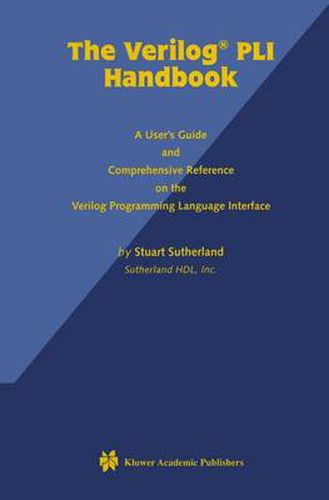Readings Newsletter
Become a Readings Member to make your shopping experience even easier.
Sign in or sign up for free!
You’re not far away from qualifying for FREE standard shipping within Australia
You’ve qualified for FREE standard shipping within Australia
The cart is loading…






This title is printed to order. This book may have been self-published. If so, we cannot guarantee the quality of the content. In the main most books will have gone through the editing process however some may not. We therefore suggest that you be aware of this before ordering this book. If in doubt check either the author or publisher’s details as we are unable to accept any returns unless they are faulty. Please contact us if you have any questions.
The Verilog Programming Language Interface, commonly called the Verilog PU, is one of the more powerful features of Verilog. The PU provides a means for both hardware designers and software engineers to interface their own programs to commercial Verilog simulators. Through this interface, a Verilog simulator can be customized to perform virtually any engineering task desired. Just a few of the common uses of the PU include interfacing Veri log simulations to C language models, adding custom graphical tools to a simulator, reading and writing proprietary file formats from within a simulation, performing test coverage analysis during simulation, and so forth. The applications possible with the Verilog PLI are endless.
Intended audience: this book is written for digital design engineers with a background in the Verilog Hardware Description Language and a fundamental knowledge of the C programming language. It is expected that the reader:
Has a basic knowledge of hardware engineering, specifically digital design of ASIC and FPGA technologies.
Is familiar with the Verilog Hardware Description Language (HDL), and can write models of hardware circuits in Verilog, can write simulation test fixtures in Verilog, and can run at least one Verilog logic simulator.
Knows basic C-language programming, including the use of functions, pointers, structures and file I/O. Explanations of the concepts and terminology of digital
$9.00 standard shipping within Australia
FREE standard shipping within Australia for orders over $100.00
Express & International shipping calculated at checkout
This title is printed to order. This book may have been self-published. If so, we cannot guarantee the quality of the content. In the main most books will have gone through the editing process however some may not. We therefore suggest that you be aware of this before ordering this book. If in doubt check either the author or publisher’s details as we are unable to accept any returns unless they are faulty. Please contact us if you have any questions.
The Verilog Programming Language Interface, commonly called the Verilog PU, is one of the more powerful features of Verilog. The PU provides a means for both hardware designers and software engineers to interface their own programs to commercial Verilog simulators. Through this interface, a Verilog simulator can be customized to perform virtually any engineering task desired. Just a few of the common uses of the PU include interfacing Veri log simulations to C language models, adding custom graphical tools to a simulator, reading and writing proprietary file formats from within a simulation, performing test coverage analysis during simulation, and so forth. The applications possible with the Verilog PLI are endless.
Intended audience: this book is written for digital design engineers with a background in the Verilog Hardware Description Language and a fundamental knowledge of the C programming language. It is expected that the reader:
Has a basic knowledge of hardware engineering, specifically digital design of ASIC and FPGA technologies.
Is familiar with the Verilog Hardware Description Language (HDL), and can write models of hardware circuits in Verilog, can write simulation test fixtures in Verilog, and can run at least one Verilog logic simulator.
Knows basic C-language programming, including the use of functions, pointers, structures and file I/O. Explanations of the concepts and terminology of digital